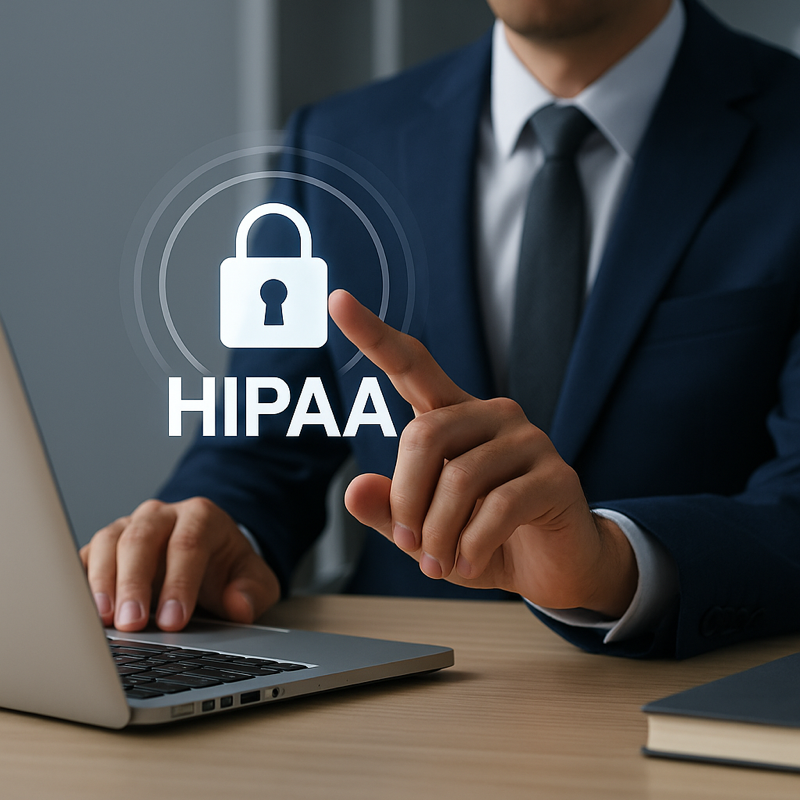As health care marketers continue down the path toward precision targeting, it has never been more critical to strike a delicate balance between innovation and privacy. HIPAA collides with digital targeting in 2025 in ways that require increased scrutiny, planning, and complete transparency. Marketers must balance the ability to send deeply relevant, segmented campaigns with an identical commitment to data security and compliance.
At EsperienzaRx, we help healthcare brands navigate this complex landscape with emphasis and expertise. Here’s how B2B healthcare marketers can ethically and effectively engage individuals in today’s privacy-conscious digital landscape.

Navigating the complex landscape where HIPAA collides with digital targeting in 2025 requires increased scrutiny, planning, and transparency. Credit: ChatGPT, OpenAI.
Safe Data Use: Accuracy Without Intrusion
The Health Insurance Portability and Accountability Act (HIPAA) never intended to apply to modern advertising. However, as web targeting has become more accurate, the potential for inadvertently mishandling covered health information (PHI) has increased.
What is PHI?
Health information that individuals can identify, such as diagnosis codes, medications, or medical device use, associates with a specific individual or can be reasonably inferred from online conduct.
Best Practices for Safe Use of Data in 2025
- Avoid mentioning condition targeting without de-identification. For example, Meta ad serving directly targeting people with a diabetes diagnosis without their explicit permission is a HIPAA offense if PHI is involved.
- Use privacy-safe data segments. Utilize third-party solutions that offer healthcare-compliant audiences built on de-identified or modeled data.
- Be cautious with remarketing. Retargeting based on visits to sensitive pages (e.g., treatment pages) must not include any data about the user that could be used to determine an individual’s health status.
The United States Department of Health and Human Services made it clear that HIPAA not only covers entities and business associates, but also third-party digital platforms collecting or processing health-related data.
Consent and Ad Platforms: A Moving Target
Consent underpins accountable digital targeting. Marketers must ensure that they clearly disclose and properly manage the collection and use of data with evolving platform policies and increased regulatory focus.
Platform-Specific Considerations:
- Meta (Facebook/Instagram): Meta restricted targeting options for sensitive health topics in 2024. Custom audiences derived from off-platform activity must navigate more stringent consent gateways.
- Google Ads: Google prohibits remarketing on certain healthcare keywords and prohibits personalized advertising on topics like fertility, addiction, and HIV.
- Programmatic DSPs: Most demand-side platforms have “HIPAA-compliant” targeting, but advertisers must verify how audiences are constructed and whether user consent is traceable back to the source.
- Clear opt-in: For email, SMS, and retargeting operations, an opt-in should clearly indicate what type of communication will follow.
- Cookie and pixel disclaimers: Ensure your website contains a compliant privacy policy and allow users to manage tracking preferences.
- Record consent history: Maintain records that verify consent has been granted, renewed, or withdrawn—a critical element in the event of audit.
As federal law lags behind in technology, pioneer states like California, Colorado, and Virginia have passed stringent data privacy laws (e.g., CPRA, VCDPA), further limiting the targeting of digital identifiers and sensitive health information.
EsperienzaRx: Your Partner in Compliant Digital Growth
As technologies for targeting evolve, so do regulations. At EsperienzaRx, we stay ahead of regulatory developments and ad platform advancements to help our healthcare clients scale responsibly. From building privacy-aligning audience plans to implement consent regimes, we help you build campaigns that convert—without losing trust. No matter whom you’re reaching—the doctors, the patients, or the caregivers—we will help you market smarter, not riskier.
A Balance Found: Creativity Powered by Compliance
In spite of all these limits, effective campaigns are actually very possible. Brands must shift from being invasive to enlightening, using contextual targeting, learn-and-educate value, and de-identified audience knowledge to drive performance.
Effective strategies are:
- Publisher site contextual targeting for general health, specialties, or disease education
- Job title or modeled behavior lookalike audiences rather than medical conditions
- Educational landing pages optimized specifically to inform and not create PHI risk
- Real-world evidence stories that add depth without compromising individual identities
The focus is away from the most granular audience identification and towards communicating the most effective message—safely.
Working with HIPAA and digital targeting in 2025 requires more than a nod to compliance—it requires an ethical mindset, technical acumen, and a firm grasp of rapidly evolving regs. With the right plans in their toolkit, healthcare marketers can continue to push boundaries without compromising on the privacy and dignity of the audiences they target.
Want to know if your current digital campaigns are HIPAA-compliant? Reach out to EsperienzaRx to schedule a privacy audit and campaign strategy session.
Frequently Asked Questions (FAQs)
How can healthcare marketers ensure compliance with HIPAA when using digital advertising platforms?
Marketers must avoid using identifiable health information for targeting unless they obtain proper consent to stay compliant. They should use de-identified audience segments, avoid condition-specific retargeting, and confirm that any third-party platforms follow HIPAA and state-level data privacy regulations.
What types of data are considered PHI in digital marketing?
Protected Health Information (PHI) includes any data that can identify an individual and relates to their health status, diagnosis, treatment, or care. In digital marketing, this includes behavioral signals like visiting a condition-specific webpage if tied to personal identifiers like IP addresses or device IDs.
Are platforms like Meta and Google Ads safe for HIPAA-compliant healthcare advertising?
They can be used safely if marketers avoid personalized ads related to sensitive health topics and adhere to each platform’s advertising policies. Meta and Google have strict guidelines for healthcare marketers, including limitations on retargeting and sensitive audience targeting.
What’s the best way to collect consent for healthcare advertising in 2025?
Marketers should use explicit opt-in mechanisms on websites, clearly disclose tracking practices in privacy policies, and implement cookie management tools. Securely store consent logs to meet audit requirements under HIPAA and evolving state privacy laws.